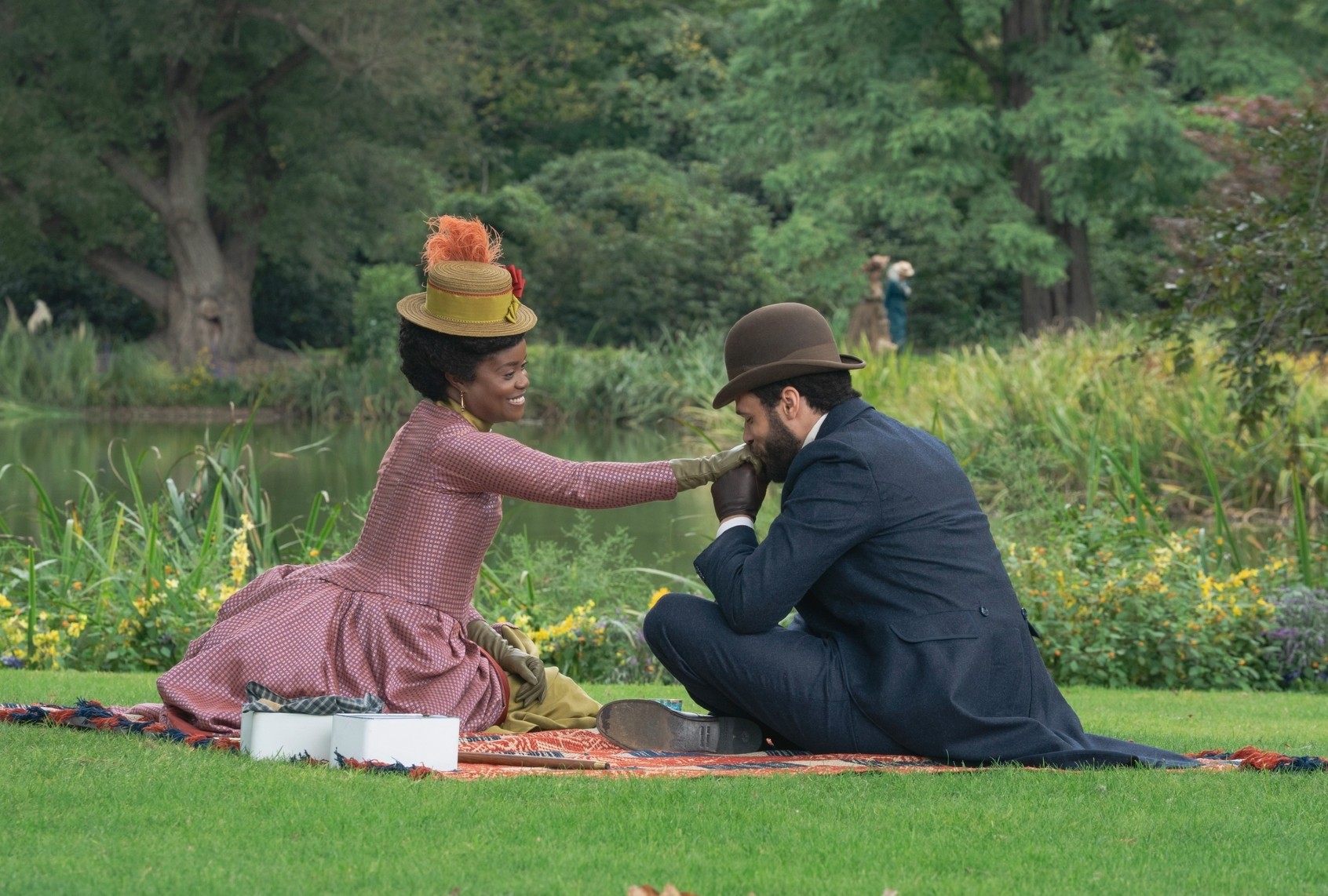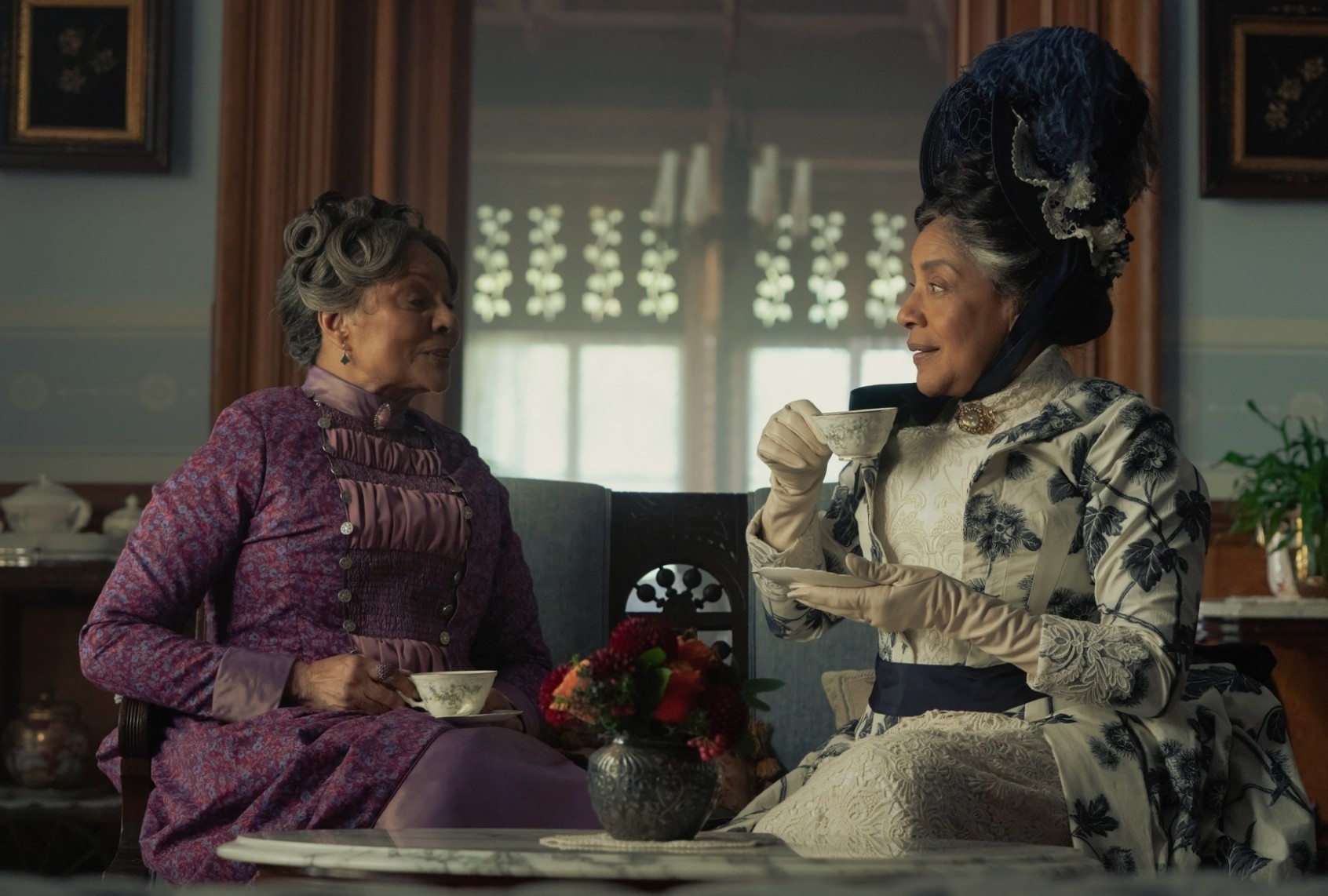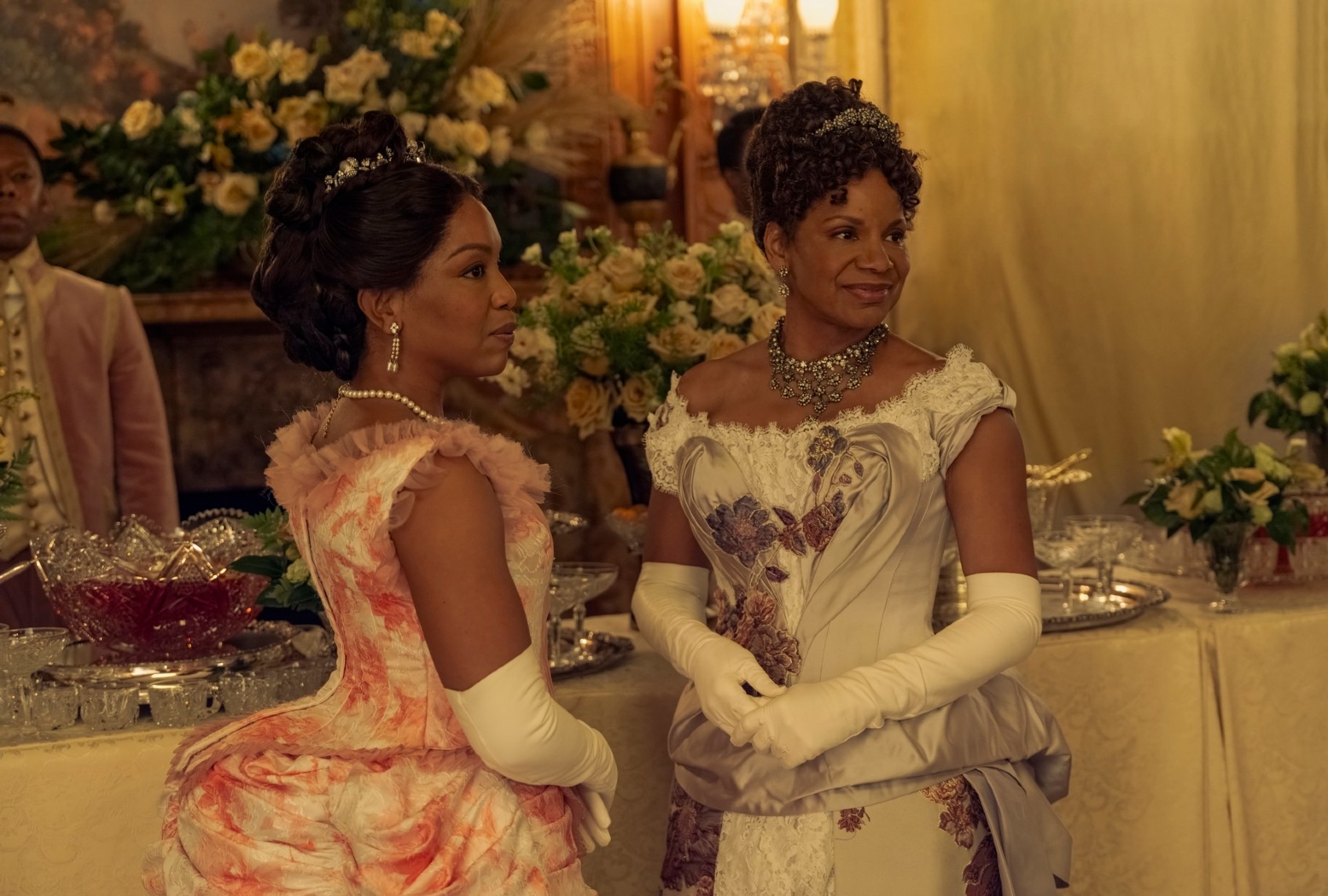Conspicuous excess being the true star of “The Gilded Age,” the season finale demanded a level of dazzle unmatched by anything that came before. But the Season 3 closer, “My Mind is Made Up,” matches that challenge by culminating in Bertha Russell’s (Carrie Coon) long-awaited ball, marking the end of the social season in Newport, Rhode Island.
For Bertha, hosting the ball completes a social and political hat trick. Her husband, George Russell (Morgan Spector), has secured the wealth and backing he needs to make his transcontinental railroad ambitions a reality. She’s married her daughter Gladys (Taissa Farmiga) to a British duke. Now, with the imperious Mrs. Astor (Donna Murphy) paralyzed by her child’s divorce scandal threatening to taint her flawless reputation, Bertha swoops in to produce the event of the year.
Peggy and William’s seaside courtship is vital scenery infrequently dramatized in fictionalized histories. From the start, “The Gilded Age” has taken care to authentically depict Peggy’s narrative trajectory without denying the same juicy intrigues coloring other characters’ lives.
The show’s costume and set production this season were already on fire, but this episode tops all that came before. Exquisite gowns and tiaras shine in the electric “display of illumination” – Bertha’s fancy description for strings of garden lights – brightening the sumptuous garden. The Russells’ Newport estate is a temple of overindulgence.

(Karolina Wojtasik/HBO) Denée Benton and Jordan Donica in “The Gilded Age”
More modest, but no less fantastic, is another social gathering taking place nearby serving the same purpose for Black society, hosted by the family of Mrs. Elizabeth Kirkland (Phylicia Rashad). What that ball has that Bertha’s lacks is a more profound romantic satisfaction.
In a season partly built around Gladys, a robber baron’s daughter, marrying into a royal title, the blossoming romance between Peggy Scott (Denée Benton) and Dr. William Kirkland (Jordan Donica) has been more satisfying to watch on several levels. Gladys’ marriage is the product of a financial arrangement brokered by Bertha, of which George disapproves.
But Peggy and William’s affection is real and worth fighting for. They create another kind of electricity that highlights Black Newport’s society ball when William strides onto the dance floor, politely interrupts Peggy’s waltz with another gentleman, and drops to one knee to propose. The moment slows down ever so slightly so we can drink it in. Peggy’s gown and skin glow.
This intimacy feels intentional. Peggy and William’s relationship overcomes social barriers having to do with class disparity and internalized racist stratification within the East Coast’s Black elite. Peggy’s family, the Scotts, are a well-to-do pillar of Brooklyn’s Black community headed by a formerly enslaved man who became a pharmacist and built his upper-middle-class family’s wealth from the ground up.
But the Kirklands come from different stock. Elizabeth snidely informs Peggy and her parents, Dorothy (Audra McDonald) and Arthur (John Douglas Thompson), that they are descended from Black Americans who were never enslaved. Moreover, her forebears fought in the Revolutionary War. And when the Scotts overhear Elizabeth yell at the family’s nanny for letting her grandchildren play outside without parasols, that reveals her disdain for dark complexions.
Inclusive casting in European period dramas is a recent development that’s been celebrated more than attacked.
Upsetting as these demonstrations of classism and colorism are, Peggy and William’s seaside courtship is vital scenery infrequently dramatized in fictionalized histories. From the start, “The Gilded Age” has taken care to authentically depict Peggy’s narrative trajectory without denying the same juicy intrigues coloring other characters’ lives. This is a factor of series creator Julian Fellowes tapping Sonja Warfield as his co-showrunner and hiring Black writers for the room, proving the benefit of insisting on diversity in storytelling perspectives.
Just as importantly, it lends an extra legitimacy to the show’s fictional interpretation of this moment in history. Inclusive casting in European period dramas is a recent development that’s been celebrated more than attacked. Still, some of these efforts are enacted more awkwardly than others. Series creators are correct in asserting that plenty of Black, brown and Asian people have been living in Europe for centuries. Justifying the multicultural casting in “Bridgerton,” a Regency-era fable, is simpler than explaining the presence of non-white nobles in Emperor Peter III’s Russia as depicted in “The Great.” One series that executes this well is Hulu’s short-lived “Harlots.”
That Black people played a foundational role in American history isn’t a question, although depictions of the breadth and variety of that experience are still rare. And presenting Black characters whose family names predate the Declaration of Independence is practically unheard of.

(Karolina Wojtasik/HBO) Leslie Uggams and Phylicia Rashad in “The Gilded Age”
To white Americans with old money bloodlines, a family tree linked to the American Revolution era carries substantial weight. But I’m wagering a large share of “Gilded Age” viewers had no idea that free Black folks and other people of color set down roots in colonies that paid for their children and grandchildren in the form of generational wealth. Through the Kirklands and Scotts, we get to see what Gilded Age prosperity looked like for a privileged subset of Black Americans about which most viewers were never aware.
Few watch “The Gilded Age” for its historical accuracy. Nevertheless, wondering how much of it is based on reality is only natural. There are plenty of historic links on the white New York side of the story: The Astors are a known name in the Old Money world, and other figures, like Nathan Lane’s Ward McAllister, existed too. Bill Camp’s J.P. Morgan founded an American financial institution that figures prominently in today’s economic landscape.
From there, Fellowes and Warfield made up most of the names for the drama’s principal characters, although the Russells’ rise closely mirrors that of the Vanderbilts.
Fellowes, who created “Downton Abbey,” originally intended to introduce Peggy as pretending to be a domestic for the van Rhijn household. But at the urging of Benton and historical consultant Dr. Erica Armstrong Dunbar, she became the secretary to Agnes van Rhijn (Christine Baranski) and her sister Ada (Cynthia Nixon), who, along with their niece Marian Brook (Louisa Jacobson), encourage Peggy’s writing career.
Past seasons introduced actual Black historical figures, including newspaper editor T. Thomas Fortune (played by Sullivan Jones) and Booker T. Washington (Michael Braugher).
But as Dunbar explains in the drama’s official podcast, the third season’s Newport storyline is largely unexplored history.
We need your help to stay independent
The standard post-Reconstruction American Black experience follows the sharecroppers’ narrative. Their stories of pain, struggle and resilience in the face of Jim Crow are crucial to honoring Black people’s place in history, especially under an administration bent on diluting or erasing those histories.
Almost immediately after being sworn in to his second presidency, Donald Trump took aim at Black history and that community’s prosperity legacy under the guise of banishing diversity, equity and inclusion from American culture.
The Scotts’ Newport chapter tells a story of Black excellence and joy that’s equally as central to the American story. Importantly, that prosperity isn’t dependent on their white society counterparts, who hold more of the country’s wealth and do not view them as equals.
A March executive order railed against “improper ideology” and “divisive narratives,” targeting the Smithsonian Institution’s National Museum of African American History and Culture for a historical purging. Other government agencies took it upon themselves to remove references to renowned Black heroes, including the Tuskegee Airmen. The United States National Park Service began scrubbing its exhibits about Harriet Tubman and the Underground Railroad, but public pressure reversed that erasure.
Those signals endorse the continued omission of those stories from educational curricula that barely included them in the first place. The 1921 racist massacre in Tulsa, Oklahoma, and the resulting decimation of the booming wealth center known as Black Wall Street, aren’t included in elementary and high school textbooks. Many first learned about that dark history chapter through another hit HBO series, “Watchmen.”
But again, these chapters codify the Black American experience as one defined by pain and primarily linked to chattel slavery. The Scotts’ Newport chapter tells a story of Black excellence and joy that’s equally as central to the American story. Importantly, that prosperity isn’t dependent on their white society counterparts, who hold more of the country’s wealth and do not view them as equals.
Although “The Gilded Age” doesn’t ignore the racism the Scotts and Kirklands confront in their social circles’ limited interactions, Fellowes and Warfield’s focus more intently on the dignity and grace with which they confront their offenders. Peggy and William’s meet-cute is only possible because the van Rhijns’ white family doctor refuses to treat Peggy when she falls ill, leading the Scotts to escort William to Brooklyn and their daughter’s sickbed.
Start your day with essential news from Salon.
Sign up for our free morning newsletter, Crash Course.
Because of their courtship — which takes a few twists, owing to Elizabeth’s gossipy meddling — William is nearby when an assassin shoots George at his office. His excellent training saves the show’s favorite captain of industry.
Once George regains consciousness, he rewards William with an untold sum that makes the physician’s eyes widen. William already has a successful practice, but it’s implied that this boon may assist him in settling up a household independent of his parents’ financial or emotional support. (William’s father, Frederick, played by Brian Stokes Mitchell, is warmer to Peggy than Elizabeth, which helps.)
This is a happier ending than even Bertha Russell enjoys. While she closes this chapter on the peak of New York’s social pyramid, the society queen’s marriage is very much on the rocks. George never approved of Bertha using Gladys as currency to secure their power in society, regardless of what that successful union gains them. As he rides away from a weeping Bertha, Gladys shares the news with her mother that she’s pregnant.
Provided Peggy and William make it to the altar, any crises they face aren’t likely to spill into New York’s society gossip columns. But the possibility that they might inspire people to surface accounts of their historic parallels lends an extra satisfaction to a fantastic season of “The Gilded Age.” Their love affair isn’t the stuff of fairy tales, and that’s the best part.
All episodes of “The Gilded Age” are streaming on HBO Max.
Read more
about this topic


